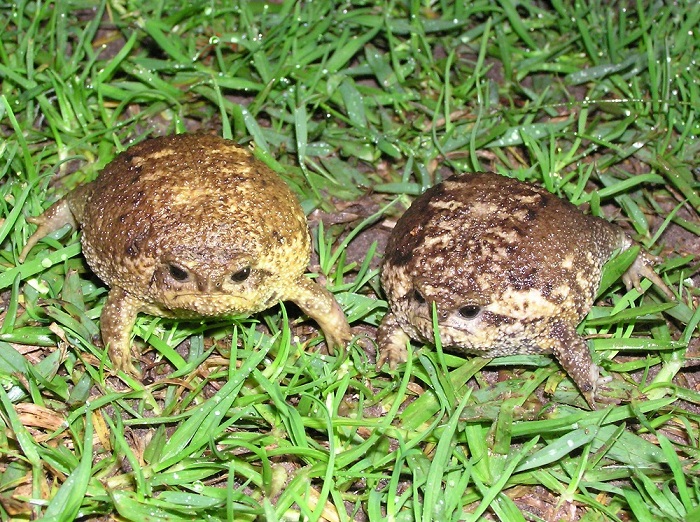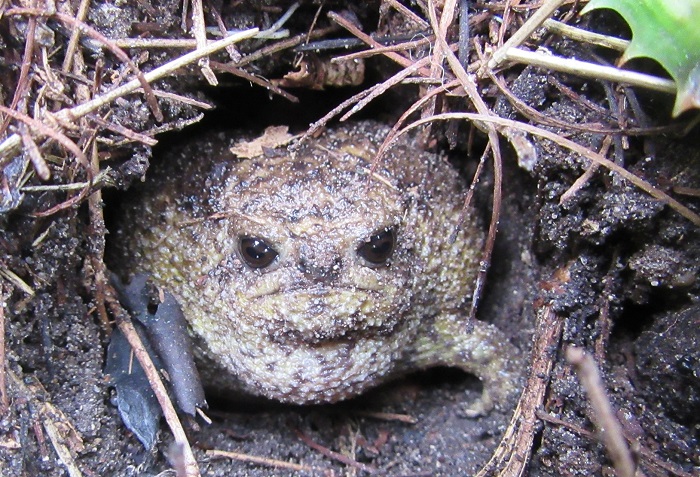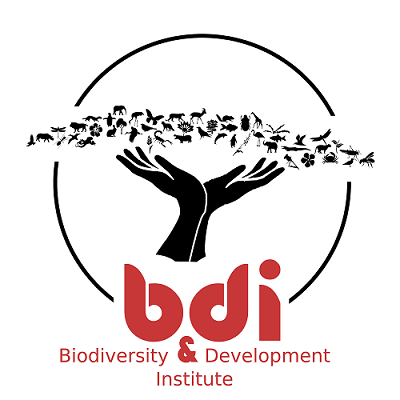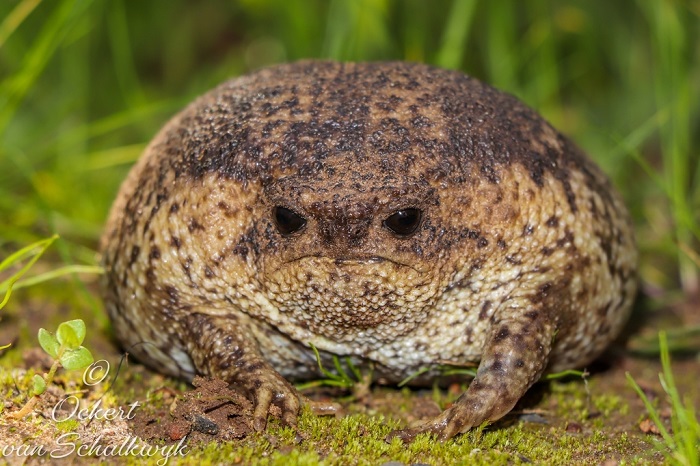View the above photo record (by Ockert van Schalkwyk) in FrogMAP here.
Find the Cape Rain Frog in the FBIS database (Freshwater Biodiversity Information System) here.
Family Breviceptidae
CAPE RAIN FROG – Breviceps gibbosus
(Linnaeus, 1758)
Habitat
Most localities where B. gibbosus occurs have fine-grained, heavy substrates (loamy soils and clays) derived from shales or granites, which is the substrate associated with West Coast Renosterveld. This veld type occurs in winter-rainfall areas with annual precipitation of 300–600 mm. Less than 3% of the original extent of this veld type still exists, mainly as a consequence of crop agriculture, principally wheat (Low and Rebelo 1996). The remaining renosterveld is now severely fragmented, with the largest fragments being located on hills and mountain slopes, where B. gibbosus is usually found. However, this species is not recorded from all renosterveld fragments, of which many have not yet been surveyed for the species. It is therefore difficult to make a definitive statement about the link between B. gibbosus and this particular vegetation type. It may be that this species was always more common in well-drained upland situations, or possibly in more wooded situations where ground temperatures are moderated.B. gibbosus also occurs in disturbed and altered habitats, such as pine plantations and suburban gardens. It is virtually absent from the sandy areas of the Cape Flats (De Villiers 1988b), but in gardens it has been found in sandy substrates where it appears able to flourish (J.A.H. pers. obs.). Its occurrence in some of these suburban situations is probably the result of the transportation of topsoil for use in gardens.
Behaviour
B. gibbosus survives the long, dry summers by aestivation underground. Individuals produce a thin cocoon around themselves, with nostrils plugged and body inflated (Channing 2001).Calling commences with the first winter rains (late April) and continues through to November. Calling occurs day and night in wet weather. Calling peaks at the beginning of winter and in spring, from late August to October (A.L. de Villiers pers. comm.), suggesting that warmer temperatures stimulate calling.Although calling usually occurs during and after rain showers, it sometimes precedes the rain by a few hours (J.A.H. pers. obs.; R. Boycott pers. comm.), suggesting that this species may be able to detect the drop in barometric pressure that occurs in advance of a frontal weather system. Poynton and Pritchard (1976) noted a similar apparent connection between barometric pressure and surface activity in B. adspersus and B. verrucosus.Male B. gibbosus call from the surface, that is, they have never been observed calling from elevated perches as in some other Breviceps species. Calling males are usually well hidden under vegetation, in shallow depressions in the substrate (L.R.M. pers. obs.).As in other Breviceps species, adhesive amplexus is employed when mating (Gow, in Wager, 1965). In dense choruses, males will attempt to clasp any moving object in the vicinity, including other males. On one occasion, a compact mass comprising six males clinging to one another, was seen rolling slowly down a slope (L.R. Minter pers. comm.). Rose (1962) was given a gibbosus pair and egg-cluster of about 30 eggs taken from “a cavity five inches across by three inches high, ten inches below the surface”, while Gow (in Wager, 1965) unearthed a pair with 19 young, in May. McLachlan (1978) recorded nests that contained 13 and 22 young. An adult pair, placed in an outdoor enclosure in early October, produced a nest of 18 froglets (12–13 mm in length) that were discovered emerging on 6 May the following year (A.L. de Villiers unpubl. data).

Photo by Felicity Grundlingh
Status and Conservation
Status
B. gibbosus was previously listed as Vulnerable (McLachlan 1978; Branch 1988) and Near Threatened (Harrison et al. 2001). Reassessment for this publication has placed it in the Vulnerable category, based on a restricted extent of occurrence and area of occupancy, an inferred drastic reduction and fragmentation of its range by urban and agricultural development (mainly 50–100 years ago), and ongoing pressure on local populations by increasing density of suburban development and the possibility that some of its renosterveld habitat may yet be put under the plough. Note that this assessment is made despite the fact that its range is now more extensive than previously known: the localities north of Piketberg were discovered only during the atlas period. B. gibbosus occurs in the Cape Peninsula National Park, Tygerberg, Paarl Mountain and Voëlvlei nature reserves, and Elandsberg Private Nature Reserve (near Hermon). The species is legally protected by Nature Conservation Ordinance 19 of 1974. At present, B. gibbosus is not listed by CITES.

Photo by Felicity Ellmore
Threats
The primary threat to B. gibbosus is the further destruction of both its habitat and local populations by agricultural and urban development. Fragmentation of its habitat by urban development has resulted in numerous relatively isolated populations in parks and gardens, and these are generally not protected. The long-term viability of these urban fragments is, at best, uncertain. Many individuals attempting to cross roads are killed, thus limiting inter-population gene flow. It is not known to what extent agricultural chemicals, such as pesticides and herbicides, have affected local populations, but the apparent absence of animals from most renosterveld fragments in the Swartland, north of Cape Town, suggests that this may have been an important negative factor in the past.Recommended conservation actionsThe remaining populations on the Cape Peninsula and in other urban centres, such as Stellenbosch and Paarl, should be documented in detail and afforded as much protection as is feasible. The long-term viability of fragmented urban populations should be assessed through monitoring of selected populations. Public education programmes could be a useful approach for protecting such an interesting and charismatic species. Where land developments threaten local populations, the potential for translocations of animals should be investigated. Populations that still exist in relatively undisturbed renosterveld habitat should be given special protection together with the habitat, especially as so little virgin renosterveld remains. The potential for reintroducing the species into conserved renosterveld fragments, especially those incorporating uplands, should be investigated.B. gibbosus is one of the species included in the Western Cape Nature Conservation Board’s threatened species monitoring programme (De Villiers 1997a).
Distribution
This Western Cape endemic occurs from the central Cape Peninsula in the south, to west of Citrusdal in the north. Its range does not extend into the mountain ranges to the east of the Cape Flats and the Swartland, but it does occur patchily on the slopes of Table Mountain, Devil’s Peak and Wynberg Hill on the Cape Peninsula (3318CD, 3418AB), the inselbergs of Paarlberg (3318DB, DD) in the Boland, Perdeberg (3318DB) and Piketberg (3218DC) in the Swartland, and in the Olifants River Mountains (3218DB). Surprisingly, several other likely upland localities, such as the Kasteelberg (3318BD), have not yet yielded records.The atlas data are reliable and reasonably complete at the level of the quarter-degree grid cell. Some of the renosterveld-covered hills in the wheat-farming area of the Swartland north of Cape Town, contain suitable habitat for this species but have not yet been adequately surveyed.

Further Resources
Virtual Museum (FrogMAP > Search VM > By Scientific or Common Name)
More common names: Giant Rain Frog (Alternative English Name); Kaapse Reënpadda, Aartappelpadda, Kaapse Janblom (Afrikaans)
Recommended citation format for this species text:
Harrison JA, Minter LR, Tippett RM. Cape Rain Frog Breviceps gibbosus. BDI, Cape Town. Available online at http://thebdi.org/2022/01/28/cape-rain-frog-breviceps-gibbosus/
Recommended citation format:
This species text has been updated and expanded from the text in the
2004 frog atlas. The reference to the text and the book are as follows:
Harrison JA, Minter LR 2004 Breviceps gibbosus Cape Rain Frog. In Minter LR
et al 2004.
Minter LR, Burger M, Harrison JA, Braack HH, Bishop PJ, Kloepfer D (eds)
2004. Atlas and Red Data Book of the Frogs of South Africa, Lesotho and
Swaziland. Smithsonian Institution, Washington, and Avian Demography
Unit, Cape Town.

